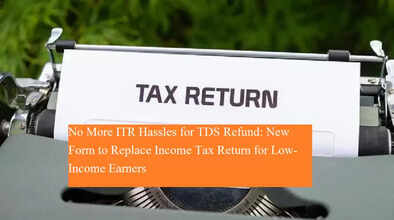No More ITR Hassles for TDS Refund: New Form to Replace Income Tax Return for Low-Income Earners

In a significant move aimed at simplifying the income tax filing process for low-income individuals, the Indian government is proposing a major relief in the Income Tax Bill 2025. As per the proposal, taxpayers whose income falls below the taxable threshold may no longer be required to file an Income Tax Return (ITR) just to claim a TDS (Tax Deducted at Source) refund.
This provision, once approved, will bring substantial ease, especially for salaried individuals who face unnecessary ITR filing only to recover excess tax deducted at source.
ITR Filing to Become Optional for TDS Refunds
Traditionally, even individuals with non-taxable income have had to file an ITR if TDS was deducted by their employer or financial institution. This was a technical but mandatory process to claim refunds. However, the proposed amendment in the Income Tax Bill 2025 is set to change this approach.
According to a report by Hindustan Times, a Select Committee studying the bill has recommended the elimination of ITR filing for individuals whose total income is below the tax exemption limit but have had TDS deducted.
What Will Replace ITR?
Instead of filing an entire income tax return, affected taxpayers will be able to submit a simplified refund claim form based on the details available in Form 26AS — a consolidated annual tax statement issued by the Income Tax Department.
The Central Board of Direct Taxes (CBDT) is currently designing this simplified form, which will be pre-filled with the TDS details pulled directly from Form 26AS, making the refund process automated, faster, and hassle-free.
Major Relief for Small Earners
Under the new tax regime, individuals earning up to ₹12.75 lakh annually may not be liable to pay tax, provided they have submitted all required investment and deduction documents. However, in many cases, employers still deduct TDS if proper documentation is not submitted in time.
This leaves many salaried individuals — especially first-time earners, freelancers, and retirees — with the burden of filing ITRs solely to recover TDS, despite having income below the taxable slab. The new proposal will provide direct relief to this segment of taxpayers.
Enhanced Transparency Through Digital Access
The bill also includes provisions related to digital data access for tax administration. It proposes that authorized Income Tax officials may be allowed to access taxpayer records, such as income and expense logs, accounting software, and devices, to enhance transparency and reduce tax evasion.
While privacy concerns have been raised in similar cases globally, the panel argues that regulated access with clear data-use guidelines will strengthen governance and audit mechanisms.
When Will This Rule Be Implemented?
This provision is likely to be rolled out starting April 1, 2026, after the bill is passed in Parliament during the Budget Session 2025–26. The tax reform task force has already submitted 285 recommendations, out of which this change is considered one of the most taxpayer-friendly.
Final Thoughts
The Income Tax Bill 2025 represents a modernized, taxpayer-centric approach to compliance. For millions of individuals earning below the taxable threshold, this step means no more lengthy ITR filing just to claim a refund. Instead, a quick and simple form will do the job — saving time, resources, and paperwork.
As the CBDT finalizes the process, all eyes will be on the rollout of this new system, which promises to redefine the tax refund landscape in India.

